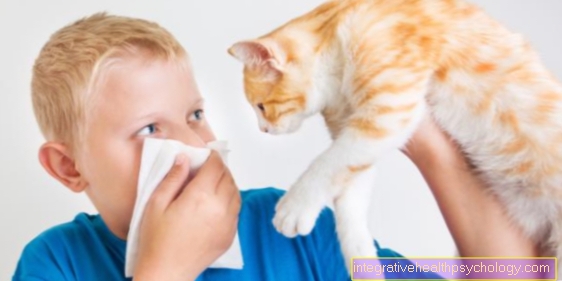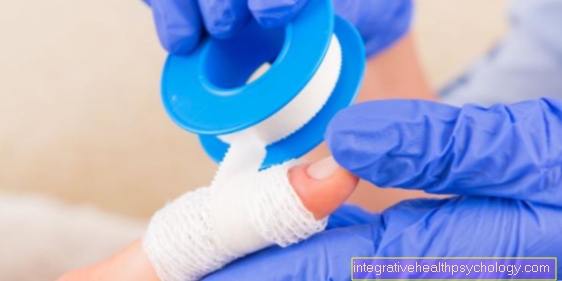Cat hair allergy
introduction
Hypersensitivity to cats is usually referred to as a cat hair allergy.
However, this term is a bit misleading, as the allergic reaction is not actually directed against the cat's hair itself, but primarily against a certain protein that is in the saliva (and also in the skin flakes) of cats.
After grooming, the saliva sticks to the hair, which can then spread particularly easily in the area.
The allergy-causing protein (also called allergen) is called Fel d 1.

It is extremely small and light, which is why it can be distributed particularly well in the air. In addition, it sticks practically everywhere, especially in textiles, but also on walls or furniture. Because of these properties, this allergen is also often found in public places to which cats have never had contact for a long time. Depending on the breed, sex and age of a cat, they produce different amounts of Fel d 1.
This fact explains why not all cat hair allergy sufferers react equally (strongly) to every type of cat. In addition, “only” 90% of those allergic to cat hair recognize the protein Fel d 1, because there are a number of other allergens: Fel d 2 to Fel d 7, which can also cause allergies.
Classification
One differentiates with the Cat hair allergy the Types 1 to 4, where the Cat hair allergy to type 1, the Immediate type, is expected.
This means that symptoms arise relatively immediately after exposure to the allergen. The allergen, in this case a specific protein, is wrongly classified as dangerous by the body of those affected. This leads to a reaction of the Immune system, which is characterized by the fact that substances are released (the histamine is particularly important here), which lead to a typical complex of allergic symptoms:
Symptoms
In the case of cat hair allergy sufferers, complaints of the nose and throat area are usually the main focus. The nasal mucosa swells, causing the nose feels blocked and runs, the nose itches, there are often real sneezing attacks and sometimes a burning sensation in the nose is described.
The eyes are often reddened and also itchy, they can also tear or swell. In contrast to people with hay fever In many cases, this is also the case with a cat hair allergy skin affected. Patients get itchy, reddened Rash, in the course of which wheals can also develop (Hives).
A dreaded long-term consequence of a cat hair allergy that occurs especially when it is allergy has existed for a long time and is not treated or not treated sufficiently, is that the symptoms spread to lower levels of the respiratory tract. About a third of all untreated cat hair allergy sufferers are affected. These patients then suffer additionally or exclusively from what is known as an allergic one asthma: It comes to Coughing fits and a wheezing with shortness of breath. All of these symptoms become particularly pronounced when an affected person is in the immediate vicinity of a cat or in a room in which cats and consequently also cat hair and the causative allergen are often found.
Cat hair allergy with cough
Cough is a very common symptom with various causes. One of them is cat hair allergy. The protein particles causing the symptoms get from the cat's saliva by licking their fur. Since the particles are very small, they can easily be thrown into the air and thus inhaled by humans.
In people with a cat hair allergy, contact with the triggers will cause one Hypersensitivity reaction of the immune system. Defense cells in the respiratory tract react by releasing tissue messenger substances that lead to coughing. The body is supposed to cough up the supposedly dangerous particles and thus fight them off.
A cough that has lasted for weeks in cat owners can also be the first sign of a cat hair allergy.
Cat hair allergy with asthma
Asthma can have different causes and occur in different situations. That is a form allergic asthma. The typical symptoms arise from contact with the respective allergen. Any form of allergy, including cat hair allergies, can in principle trigger asthma or at least lead to symptoms that are typical for asthma.
Usually a cat hair allergy with mild symptoms such as itching and Sneezing fits in front. If the allergy is not treated and the triggering allergen is not avoided, the overreaction of the immune system can intensify and the symptoms worsen. So through a contact with cats the Airways swell and it comes to acute shortness of breath. Then there is usually already an asthma that should definitely be treated, since a severe asthma attack life threatening can be.
About one in three people with cat hair allergy will develop asthma over the course of the day if the allergy is not treated. One also speaks of a so-called "Change of floor", Because the hypersensitivity reaction no longer only takes place in the nose and throat, but also in the airways of the bronchi and lungs (ie" one floor below ").
What are the signs of a cat hair allergy
Typical signs of a cat hair allergy are Sneezing fits or itchingwhich occur particularly when a cat is nearby or in an environment where cats are present. However, these unspecific symptoms can also be caused by other triggers, such as a house dust allergy. An allergy is more likely if the symptoms only affect you and not other people in the same environment.
to cough
The Allergy to cat hair is one of the most common Pet hair allergies and is often accompanied by various symptoms.
In addition to the hair, proteins can also trigger the allergy skin, saliva or Sweat be the cat.
A typical symptom can be an acute one to cough and Respiratory problems be. This cough can prove to be more acute coughing attack express or appear as a long-lasting and recurring cough. Especially inflammation of the throat and throat, which is also caused by a allergy can further irritate and worsen a cough.
The cough can be particularly dangerous if the structures of the respiratory tract swelling.
Those affected can then quickly move into panic and suffer an acute attack of breathlessness. It is then particularly important to remain calm and to instruct the patient to breathe calmly. A cough caused by animal hair should always be clarified by a doctor.
Further information can also be found under the topic: to cough
diagnosis
The suspicion that a cat hair allergy is present is usually expressed by those affected themselves.
In order to have this suspicion confirmed, however, it makes sense to consult a doctor, since the symptoms often coincide with the symptoms of other allergies or infections bacteria or Viruses can be confused. A doctor will always first take a detailed medical history.
Among other things, important questions are:
- which complaints are present,
- how often and when exactly they occur,
- can they be triggered, improved or made worse by certain activities,
- there are similar symptoms also in family members,
- there are other known diseases and / or allergies and, depending on the individual case, even more.
This is followed by a physical examination. During this, the doctor examines the eyes, nose and paranasal sinuses and, if necessary, the affected skin areas. After these measures, a suspicion has usually already been confirmed, but can still be confirmed and refined by certain tests.
There are various skin tests that can be used to detect allergies. The so-called prick test is the most common. In this test, the doctor applies various allergens that have been diluted in solution, which could be responsible for the symptoms, to the patient's forearm and then pierces the skin with a small lancet in the center of the droplets, so that the allergens enter the body reach.
An allergic reaction has occurred in those areas where redness and / or wheals appear within ten to twenty minutes.
Learn more about: The prick test
If the result is unsatisfactory, the prick test can be supplemented by an intracutaneous test in which the allergens are injected directly under the skin, making this test more accurate, but also more painful. A blood test can also provide information about a questionable allergy. However, this is usually only carried out if the prick test cannot be carried out for any reason or if the results are unclear.
Blood is taken, which is then sent to a specific laboratory in the laboratory Antibody subtype (IgE, which is increasingly released in the context of allergic reactions) is examined.
Here you can do that Total IgE, i.e. all IgE antibodies that are present in the blood, but this is only of limited significance as it can also be determined by other factors (such as Worm infections or Smoke) can be increased. It is better to be specific IgE to determine which one is directed against a specific allergen, in this case the cat hair allergen. If this value is increased, it is almost positive in connection with the appropriate clinical picture 100% for an existing cat hair allergy. The last option is this Provocation test.
In this test, the patient is confronted directly with the suspected allergen, for example by bringing it into contact with the mucous membrane of the eye or nose.Since this test can sometimes cause severe allergic reactions, it is rarely used and must only be carried out under strict supervision.
Important differential diagnoses of a cat hair allergy are other allergic diseases, for example hay fever, allergies to other animal hair, Food allergy or Drug allergies. Some infections (viral, bacterial or even by worms), certain changes in the nasopharynx or even hormonal disorders can rarely cause comparable symptoms, which is why a thorough diagnosis should not be neglected even if there is an apparently obvious cat hair allergy.
Cat hair allergy test
If there is a suspicion of a cat hair allergy, a doctor (this can initially be the family doctor) should first conduct a careful questioning of the symptoms. This includes when they occur, which symptoms appear and how long they last. If the suspicion is confirmed by the doctor, special allergen testing can be carried out.
These examinations are usually covered by the statutory or private health insurance. But there is also the possibility of ordering an animal hair allergy test kit with all the necessary utensils, for example on the Internet. A drop of blood can be removed from the finger and sent to a laboratory with the help of devices and instructions suitable for laymen. There the blood is examined for certain components that suggest a cat hair allergy. A detailed evaluation is then sent to you. Such a test is available for around € 25.
However, a positive test result alone by no means confirms the diagnosis of an allergy! An allergy can only be diagnosed if there is actually a hypersensitivity reaction of the immune system through contact with the relevant allergen (in this case cats).
With an allergy test kit, you can initially avoid a visit to the doctor if you want to know whether you suffer from a cat hair allergy. However, a negative test result does not rule out the allergy with certainty. On the other hand, if the test result is positive, a doctor should be consulted anyway in order to be advised on how to proceed.
also read: Allergy test
Cat hair allergy therapy - how is it treated?
The most important part of a therapy against a cat hair allergy is of course to prevent exposure to the allergen as consistently as possible ("Allergen avoidance“).
This means that you should never keep a cat as a pet, but you should also have as little contact as possible with cats and places in which they are often in general.
For the reasons mentioned above, however, it is hardly possible to avoid all contact with cat allergens. Therefore often need additional Medication can be used to get the complaints under control. Against allergies in general will usually be Antihistamines prescribed in the form of Tablets, Anoint, eyes- and Nasal drops are available. Which of the many preparations works best in which dosage always has to be decided individually and it can sometimes take some time to find the optimal mode of application.
But even if this therapy often helps relatively well, it is purely symptomatic. If you consider the problem causally (causal) want to tackle, ultimately only one comes Desensitization (also: desensitization) in question. In this treatment, the patient is injected with the relevant allergen under the skin at regular intervals over a longer period of time, initially in a very low concentration and then in an increasingly increasing concentration. This is supposed to immune system Gradually get used to the allergen and finally stop overreacting to it if you encounter it under normal conditions.
Can you cure a cat hair allergy?
Theoretically, a cat hair allergy is with the so-called desensitization (erroneously also called "Allergen vaccination“Designated) curable. The immune system is treated with small amounts of the triggering protein particle (Allergen) and used to it with slowly increasing dosage. However, this therapy is great tedious and often unsuccessful.
Much more effective and faster than striving for a cure is that Avoid allergenic element. For cat owners, this means parting with the cat.
Another option is to use medication to curb allergy symptoms. In some cases the hypersensitivity can subside over the years and a cure can be achieved. Unfortunately, especially in people who are still in contact with cats, the symptoms continue to increase as long as there is no treatment.
desensitization
The principle of desensitization is based on the body's own defense system (immune system) to first confront the smallest amounts of the allergen. These are gradually increased with the aim of reducing the overreaction to the harmless trigger. The immune system should get used to these and recognize that there is no danger from them.
In the case of cat hair allergy, the trigger is not cat hair, but rather certain proteins from the animals' saliva, which are distributed in the hair by the grooming process. For other allergies, it is certain pollen or insect venom.
With a successful desensitization, which lasts two to three years, one is freed from the allergy and shows no more symptoms. While the chances of success are very good with some forms of allergy (for example with bee or wasp allergies), the treatment of cat hair allergies often works less well. This is partly because the trigger (i.e. the cat) should be avoided during therapy for successful treatment. The elaborate desensitization is particularly suitable for people who do not want to part with their animal. Treatment is then still possible, but significantly less promising.
For this reason, it is not covered by health insurance in all cases. It is therefore advisable to find out before the treatment whether the health insurance company will cover the costs or whether you will have to pay them yourself.
Further information is available under our topic: desensitization
Medication
The best and most direct action in the event of an allergy is to do so Avoid triggers. This is a very large and difficult step for most cat owners. The symptoms of the allergy are also often not too restrictive, so that a cat can usually still be kept.
Fortunately, there are several measures that can be taken to alleviate the discomfort. At skin allergic symptoms such as itching, rash, or reddening of the skin, certain often help Creams from the pharmacy or drugstore. Active ingredients like urea (urea) and Aloe vera are recommended.
Read about this: Treat rash with ointments and creams
Since the allergic reaction to the proteins of cats is mediated by the release of the tissue hormone histamine, allergy sufferers can also so-called Antihistamines take to contain the acute reaction. Frequently used according to a doctor's prescription Cetirizine and Lorano®. These can also be taken preventively, for example if contact with the allergen cannot be avoided, such as when visiting an apartment where cats also live. The tablets can also help to contain an incipient reaction.
When allergic Shortness of breath can also be certain Inhalation sprays can be used, which quickly expand the narrowed airways again. The active ingredient is mostly beta2 symphatomimetics such as Salbutamol. People with allergic asthma should have it alongside one Adrenaline injection Carry it with you as emergency medication.
homeopathy

A Allergy to animal hair can exist from the start or is basically predisposed and can therefore also suddenly occur despite long-term contact with a house cat.
A treatment of the allergy can then also be done with homeopathic remedies be performed. This can often be done yourself or, depending on the severity of the allergy, be accompanied by a specialized therapist.
On the one hand, patients receive Acute medication from the homeopathy with low potencies to be taken every hour. For the therapy of the basic susceptibility to illness, means with high potencies are used. These are supposed to do that immune system influence and are taken once or only monthly. The aim of therapy is not to over-stimulate the patient's body.
For treatment with the help of homeopathy There are various means available that can be obtained from plants or even animals. Which means is most suitable for the patient can be determined by an experienced therapist and a Allergy test be determined.
The homeopathic remedies can then be tested for their effectiveness and it may be necessary to try several homeopathic remedies until the most effective one is found for the allergy.
Cat hair allergy in children
About every fifth child is affected by an allergy. Often it is an allergy to animal hair. Most often, cats are the trigger. A family history (i.e. if, for example, the parents or siblings already have an allergy) increases the risk.
In children, if an allergy is suspected, an early diagnosis and, if necessary, appropriate therapy are particularly important. Otherwise, there is a high risk of developing allergic asthma.
Protective measuresthat have a preventive effect on the development of allergy in children are one healthy eating and the Protection against smoke exposure. A diet with only breast milk in the first four months of life also has a positive influence.
Furthermore, the usual recommended by the standing vaccination commission (StiKo) of the Robert Koch Institute (RKI) Vaccinations respectively.
Signs of allergy that parents should look out for are seizure or more episodic Cough, reddened skin and itchy skin, Shortness of breath such as Whistling noises when breathing. If there is a cat in the vicinity or the symptoms arise after contact with cats, this is an indication of a cat hair allergy. Nevertheless, there may be another cause and an allergological test should be carried out by a suitably trained doctor.
The treatment of cat hair allergy in children does not differ significantly from the treatment of adult allergy sufferers. On the one hand, the trigger should be avoided as far as possible and a cat in the household may have to be given away. Furthermore, there is often a antiallergic medication For example, antihistamines in tablet form make sense so that the child's quality of life is not impaired too much.
The only way to combat the cause of the allergy is through the so-called Desensitization (Confrontation of the immune system with the smallest amounts of the triggering allergen to "get used to"). In many cases the symptoms are reduced and the allergy can even be cured.
A special feature of children with an allergy is that the disease changes more often than in adults. On the one hand, the responsiveness of the immune system decreases with age and the symptoms of an allergy may subside. On the other hand, however, there can also be an increase in the number of reactions in children and the allergy can even spread to other triggers. An allergy to other animal hair, food or pollen can also occur. Therefore, children with a cat hair allergy or other allergic disease should be monitored regularly by an allergist.
















.jpg)












